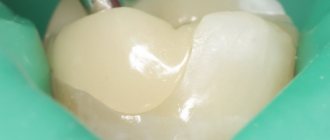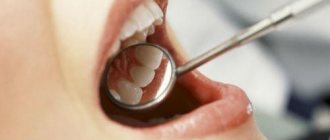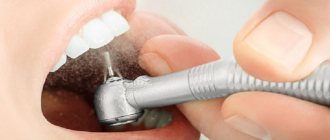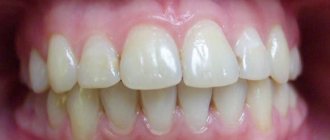Signs of a filling falling out soon
How can you tell if a filling has fallen out? This is quite simple - at the place of its installation there is no material with which the filling was made, and there is a hole. Therefore, it is better to prevent such a phenomenon and contact a specialist in advance, even before complete loss.
Determining that the filling does not stay in the tooth and will soon fall out is also quite simple. Gaps appear between the tooth surface and the filling material, which are almost invisible at first, but become larger over time. The material itself becomes loose. This is felt when you press the seal with your tongue. If such phenomena are observed, you should immediately consult a doctor so as not to be annoyed later that the filling has come out.
The cost of installing different types of fillings
The price of a filling depends on the filling material and the amount of work the dentist does. For example, treatment and filling of canals, installation of pins and other auxiliary systems increase the cost. Modern high-tech fillings - a light-curing composite - will cost from 1,900 rubles, taking into account all additional steps for preparing the tooth and final polishing. The use of a fluid composite during layer-by-layer polymerization will add 1000 rubles to the cost; a fluid composite in combined fillings will cost 400 rubles. The cost of a temporary filling is from 200 to 500 rubles, depending on the material. Installation of a pin for durable installation of the seal, if necessary - from 1,500 rubles.
Necessary actions if a filling falls out
It is important to know what to do if a filling falls out. It is advisable to immediately make an appointment with a dentist, but in some cases it is not possible to urgently visit a doctor. When a filling has come out of a tooth, you can do without it for a short time, but only for a certain time.
If treatment is delayed, the tooth may become infected, leading to acute pain and gradual destruction. It is important to visit a specialist in a timely manner, regardless of whether the filling is permanent or temporary.
But it is better to avoid such a situation and visit the dentist at the stage of loosening. Any gap or even minimal gap between the tooth and the filling is a place for bacteria to enter.
And if you don’t pay attention to such a problem in time, then you shouldn’t be surprised that the filling has fallen out between the teeth.
Most often, such troubles occur with molars. They experience a lot of stress and the filling material can be destroyed if you often eat solid foods. Fillings on the front tooth fall out much less frequently.
What will the doctor do?
Only after a thorough examination of the patient will the doctor be able to understand what treatment measures should be taken. So, if the filling crumbled due to the fact that the carious cavity was too large and the “repaired” tooth simply could not cope with the functional load, then re-filling is pointless - the dentist will recommend covering this unit with a crown.
Pulpitis, periodontitis, secondary caries - indications for dental treatment. When all procedures are completed, the doctor will place a new permanent filling. If the composite does not “retain” in the pulpless tooth, the doctor will install a pin and build a “fresh” filling onto it.
Poor quality filling material, liquid falling into the cleaned cavity (for example, saliva) during treatment are common causes of fillings falling out.
Pain after a filling falls out and other unpleasant consequences
Simple recommendations for patients on what to do when a filling falls out and a tooth hurts:
- You need to rinse with a solution of baking soda and salt.
- You can take a painkiller, it could be Ketanov or Analgin.
- During the inflammatory process, the temperature may rise. It must be knocked down after exceeding 38.5° C. For this, antipyretics are used.
- If there is bleeding from a tooth, you should immediately consult a doctor. There can be many reasons for this phenomenon, and it will be possible to accurately determine the possible problem only after an appropriate examination.
You can find many tips on how to numb a tooth at home, but the most effective option is to rinse and take appropriate medications.
When a filling with arsenic falls out, you need to carefully remove the remaining medication with a cotton swab and rinse the tooth cavity with a soda solution.
Question No. 7: is it possible to put the filling in place yourself?
The filling fell out. What else should you do before seeing a doctor? To protect the resulting cavity from bacteria and food, you can close it yourself using a piece of cotton wool or a bandage. However, such a protective barrier will have to be changed quite often. This should be done after every snack, tea or meal. Additionally, you need to rinse your mouth with antiseptics (for example, Miramistin), herbal decoctions (chamomile and sage are suitable), and a soda solution. But you shouldn’t think about making a homemade filling, or even more so gluing it. By doing this you can only aggravate the situation and cause tissue damage or infection.
Is it possible to close a hole in a tooth yourself?
The question often arises as to what can be used to seal a temporarily opened cavity if a filling falls out. People use a wide variety of materials for these purposes - from cotton wool to chewing gum, in general - everything that can be used to fill a hole at home. Under no circumstances should this be done. Before you tape a tooth, you should think about the consequences. The cavity will not be closed hermetically, which means food debris and bacteria will get into it.
Before you think about how to plug a tooth at home, it is worth considering that any material will create extremely favorable conditions for the proliferation of microbes and the occurrence of infection or inflammation. Therefore, the question of how to cover the tooth should not arise. To avoid the accumulation of food debris in the cavity, it should be rinsed regularly at least 6-7 times a day.
Is it possible to seal the hole?
Also, when a filling falls out, many often wonder what can be used to seal or seal it, or to plug the tooth, before visiting the dentist. But here it is worth learning one simple truth - you will not be able to solve this problem on your own!
If a filling falls out, you should immediately consult a dentist and do not try to close the tooth yourself. The result of such independent treatment may not be very promising. For example, you can easily get an infection or damage the cavity for the filling, as a result of which the pain may significantly worsen.
Relieving toothache is not a problem today! However, these are all extreme measures that do not replace a visit to the dentist, but only delay it. Therefore, remember that any independent intervention can always lead to very unpleasant consequences.
If this problem happens to you, be sure to thoroughly clean the cavity of the filling, make sure that no food gets in there, and do not put pieces of garlic or onion into the cavity. Take care of yourself and do not delay visiting your doctor.
Treatment process
People faced with such a problem are interested in how the tooth will be treated when the filling has fallen out. It all depends on individual characteristics, so it is worth considering the most common situations.
If the carious cavity is too large, it makes no sense to fill it again. The material will not hold and will fall out again after a short time. Therefore, the doctor will suggest alternative methods of eliminating the defect, most likely installing a crown.
If repeated caries occurs, pulpitis or other diseases develop, they must first be cured. The doctor prescribes and carries out all the necessary measures and, after complete recovery, places a new filling. If the filling material falls out of a pulpless tooth, re-filling is often also ineffective. In this case, the specialist will recommend installing a pin.
Methods for restoring the integrity of a tooth depend on its condition, so it is difficult to suggest a treatment plan without a preliminary examination.
How will a fallen filling be treated?
The solution to this problem is not difficult. The dentist will solve it very simply. Of course, in such a situation, everyone has many questions, such as whether the treatment is painful, or whether the tooth will be drilled. Let's look at what measures the doctor will take and how all the procedures are carried out step by step.
First, the doctor will prepare the carious cavity of the tooth. Using metal and diamond burs, the doctor will remove all tooth tissue affected by caries. This procedure requires special care, because the remains of caries can provoke its re-development. Even if the most expensive materials are used to fill such a cavity, there is no guarantee that the filling will last long. In this case, caries will continue to progress.
The second thing the dentist will do is correct formation of the dental cavity. Each material has its own requirements for the formation of a dental cavity for a filling.
Due to the doctor’s haste, many extremely important stages of restoration may be missed or carried out in bad faith, so for restoration and re-filling it is worth paying special attention to the choice of a specialist.
Lost temporary filling
What to do when a temporary filling falls out? It is placed to fix the medicine in the tooth cavity and prevent the entry of saliva, food debris and microbes. Arsenic, which is poisonous, is used as a medicine. Therefore, if such a situation arises, a number of measures need to be taken:
- carefully examine the tooth cavity and determine whether the medicine remains there;
- if it remains, carefully remove it with a cotton swab;
- make a warm soda solution (at the rate of 1 teaspoon of soda per glass of water);
- rinse the tooth cavity thoroughly.
When the canals are sealed, the loss of a temporary filling does not cause significant discomfort, but leaving the tooth as is is prohibited. It can be destroyed under the influence of various factors. For a filling to fail, there must be significant reasons and only a specialist can eliminate them.
If a filling with arsenic falls out immediately after visiting a specialist, you need to make a second appointment as soon as possible and have it restored. If there are several days left until the next scheduled appointment, you don’t have to reschedule it and visit the doctor when it’s scheduled. Only a dentist can tell you how long you can walk without a filling, so it’s a good idea to call and get a consultation.
Tip #1: Rinse your mouth thoroughly
If a temporary filling came out, then most likely there was a medicine underneath it (preparations based on calcium hydroxide, antibiotics, antiseptics and antimicrobial agents1), the purpose of which was to influence the diseased tooth and its canals from the inside. Under the filling materials there may also be a devitalizing paste based on arsenic.
It is important to rinse your mouth thoroughly
Medicines are covered with temporary materials not only so that they cannot leak out or be washed out by saliva and liquid, but also to protect the body from possible negative effects. For example, the same arsenic is toxic; after ingestion, it can cause poisoning, gastrointestinal upset, an allergic reaction and a rash. If the medicine comes out of the cavity and gets on the mucous membrane, this can lead to tissue irritation or burns.
To prevent the spread of medicinal compounds to the mucous membranes and their ingestion, thoroughly rinse the mouth with any antiseptic solution (for example, Chlorhexidine).
If a temporary filling falls out while eating food, do not swallow the food that was in your mouth at that moment, but rather spit it out.
Loss of fillings in children
When a child’s filling falls out, you should not ignore the problem, even if the teeth are baby. Caries and other diseases can provoke severe pain and the development of an inflammatory process.
What to do if a temporary filling falls out of a baby tooth:
- Call your doctor, consult and make an appointment as soon as possible.
- Ensure that your child maintains good oral hygiene.
- Rinse your teeth regularly to remove food debris.
Important! Fillings on baby teeth fall out for various reasons, and only a specialist can determine what causes this phenomenon. So, in any case, you cannot do without a visit to the dentist.
Prevention
To prevent permanent (temporary) fillings from falling out, it is recommended to follow simple rules:
- visit the dentist at least once every six months, even when there are no symptoms of oral diseases;
- brush your teeth efficiently, use dental floss, and mouth rinses to minimize not only the risk of fillings falling out, but also the development of any dental pathologies;
- If possible, you should avoid hard “traumatic” food, chewing of which can cause the fillings to crumble and fall out;
- The daily menu should be enriched with foods with a high calcium content (in particular, milk and its derivatives).
It is important to remember that if a filling falls out in a child or pregnant woman, a visit to the doctor is also necessary. Baby teeth must be treated, and pregnancy is not a contraindication to dental procedures. If the patient seems that problems with fillings are associated with the incompetence of the dentist (especially if they have arisen more than once), there is no need to risk the health of your own teeth; it is better to turn to another specialist.
Filling falling out during pregnancy
When a temporary filling falls out during pregnancy, this is a reason to urgently consult a dentist. Many women worry that treatment may negatively affect the course of pregnancy. Women carrying a child are certainly at risk, but doctors are well aware of the acceptable limits of exposure. If necessary, the doctor will select the optimal method of intervention so as not to harm the body.
You need to treat your teeth anyway. Carious lesions are an ideal environment for the development of pathogens that can cause much more harm to a pregnant woman than the process of restoring a diseased tooth.
If a filling falls out at the end of pregnancy - in the 3rd trimester, the doctor may postpone treatment if serious intervention is necessary to restore the tooth. In most cases, the specialist will make do with minimal temporary treatment, and will carry out complex measures carried out under anesthesia after childbirth.
Stock
-13%
Metal-free dental crown made of zirconium dioxide 40,000 rub.
35,000 rub.
get -20 %
Manufacturing of removable denture Acry Free 40,000 rub.
32,000 rub.
get -9 %
BASAL COMPLEX - Restoration of teeth on 1 jaw in 3 days 330,000 rub.
300,000 rub.
get -25 %
Teeth whitening Amazing White 20,000 rub.
15,000 rub. get
Destruction of the seal
Has the filling broken? This is evidence of its gradual destruction. This phenomenon can occur for various reasons. The main ones:
- Too much zeal when carrying out hygiene procedures. Frequent use of a hard brush can cause damage to the filling material or enamel.
- Large loads on the tooth. They occur when eating solid foods, seeds, nuts and the like.
- Poor quality filling material.
- Failure of a specialist to comply with the technological process.
What to do if a piece of the filling breaks off and your tooth hurts? This indicates that the material does not adhere tightly to the surface and a gap has arisen between the filling and the tooth. Pain is a consequence of the inflammatory process. If the pathology is not eliminated, it will develop and cause various diseases.
If a filling breaks on a dead tooth, a crown will have to be placed in any case. If a problem arises on a front tooth that is still alive, the doctor will suggest depulping it and then installing a crown as well.
Risk factors
A common reason for the loss of filling material is insufficient drying of the cavity of the “working” tooth. If the filling came out immediately after visiting the doctor, it is possible that saliva or other liquid got inside the dental unit during its installation, so the filling material simply could not fix securely.
When a temporary filling falls out and a tooth hurts, this most likely indicates that the doctor did not thoroughly clean the carious cavity of infected tissue; the work needs to be redone. If adjacent parts of the tooth have been sealed (between the lateral and chewing surfaces of the unit), the material will bear an increased functional load, so the composite may crumble and fall out.
If the temporary composite crumbles (falls out), do not panic - it is recommended to immediately make an appointment with the dentist, and before visiting the doctor, rinse your mouth with a soda-saline solution after each meal. Fillings from pulpless teeth fly out even more often.
The fact is that such a unit does not receive nutrients through the channels that are “responsible” for the strength of bone tissue; in addition, without a nerve, tooth enamel is quickly destroyed.
As a result, the filling material does not hold well in the cavity of the dead tooth. It happens that during the initial examination of the patient, the doctor initially makes an incorrect diagnosis, and, accordingly, carries out only partial treatment. This is another answer to the question why fillings fall out and toothache occurs immediately after visiting the dentist. For example, a specialist could clean the canals and remove carious lesions on the tooth, but not notice periodontitis or other local inflammatory process.
As a rule, a large carious cavity, which also includes the side surface of the tooth, is an indication for installing a crown. If the doctor decides to close it with a permanent filling, there is a high probability that it will not “last” for a long time under the chewing load and will soon fall out.
In case of a very large carious cavity, it is not advisable to install a permanent composite (sooner or later it will not withstand the chewing load and will crumble) - it is better to cover the tooth with a crown
When a dentist filling a tooth uses a low-quality material (or one whose shelf life has long expired), the risk of the filling falling out in a month or even a week is very high. If there is the slightest gap between the bone tissue and the filling material, there is always the possibility of developing secondary caries. Food particles always accumulate in the resulting cavity, saliva gets in there - the tooth begins to ache, and the old filling will sooner or later fall out.
The patient himself can provoke the problem. The main risk factor is eating “traumatic” foods (for example, toffees, nuts, seeds). Increased functional load on the “repaired tooth” will lead to the fact that the filling may crumble.
The same will happen if, after caries has been treated and a filling has been installed, the patient neglects the basic rules of oral care (does not brush his teeth well, does not use floss, rinses, etc.). Lack of “healthy” hygiene leads to the accumulation and proliferation of pathogenic microorganisms in the oral cavity - teeth can again be affected by caries, and installed fillings can fly out.
A filling fell out, my tooth hurts, what should I do?
If your tooth is sensitive after losing a filling, you most likely have open dentinal canals. Dentin canals are tiny connections between the dentin and the pulp of your tooth.
Since the only sensation that the nerves in the pulp can send to your brain is pain, without a filling, your tooth may react quite painfully to hot and cold drinks and food. Over-the-counter pain relievers may help relieve this pain (check with your doctor).
A temporary solution to stop the source of pain can be ordinary cotton wool. Since the pain is caused by open dentin canals, you can try to temporarily close them until you see your dentist. Close the dentinal canals in the exposed area of the tooth by temporarily filling it with cotton wool.
Comments
The doctor recently put in a temporary filling, told me to come back only in a week, but the tooth underneath it hurts very much, I can’t stand it, I’m very, very nervous... Is it possible to somehow pull it out ahead of time?
Kira (03/02/2020 at 00:55) Reply to comment
- Dear Kira, pain after installing a temporary filling can indicate both a pathological process and be a normal tissue reaction to the intervention. In both cases, you cannot try to remove the filling yourself, but it is not forbidden to visit a doctor unscheduled - the specialist will determine the true cause of the pain, and you will stop being nervous.
Editorial staff of the portal UltraSmile.ru (03/11/2020 at 09:04) Reply to comment
If you followed all the recommendations of your dentist, but the temporary filling still fell out, then this is a reason to think about changing your dentist. I think so. Where is the guarantee that he will then install the permanent one poorly?
Pavel (03/20/2020 at 10:07 am) Reply to comment
Good afternoon I once had a tooth crumble and its treatment took several days. They gave me a temporary filling and told me not to eat for several hours so that everything would harden. The remains of the tooth did not hurt under the temporary filling, since my nerve was removed, but if they put a temporary filling on the tooth where caries was treated, how to avoid pain?
Dmitry Ch. (03/20/2020 at 11:29 am) Reply to comment
At the appointment, the doctor began treatment and placed a temporary filling. The next visit was scheduled in five days. But the tooth began to bother me in the evening after visiting the doctor. Tell me if you need to see a doctor earlier than the appointed day
Svetlana (03/20/2020 at 11:56 am) Reply to comment
Tell me, if the temporary filling fell out over the weekend and my doctor doesn’t have an appointment for the next few days, will I have to walk around with cotton wool in my tooth? Maybe there is some special remedy for the time being?
Maria K (03/20/2020 at 12:12 pm) Reply to comment
My son is 10 years old. They put a temporary filling with medicine, the doctor told me to come back in 10 days. 5 days have passed, the tooth hurts. What should we do when we go to remove the tooth?
Tatyana (03/20/2020 at 01:03 pm) Reply to comment
Hello. I would like to know the opinion of a professional, because different doctors answer my question differently. Back in the days of the Soviet Union, I was given a filling. It does not have a very aesthetic appearance, it is dark in color and those who are not in the know always point out to me that the tooth needs to be treated. Do you think it’s worth changing it if the tooth itself doesn’t bother you and the filling is done, as they say, to last forever. Or is there some modern way to simply cover up the color of the filling? Best regards, Asya.
Asya (03/20/2020 at 14:01) Reply to comment
This is terrible, I swallowed a temporary filling, what will happen now?
Tatyana (03/22/2020 at 06:14 pm) Reply to comment
- Modern filling materials are safe and, if swallowed, do not cause serious consequences for the body. But the medications that are under them can provoke irritation and upset of the gastrointestinal tract, and an allergic reaction. But in any case, there is no need to be nervous, because the dose of medications is small, they cannot cause serious harm to an adult body. To neutralize the negative effects of medications, you can take Polysorb and an antihistamine (for example, Zodak). Also be sure to contact your dentist to have the filling reinstalled or a permanent restoration done if necessary.
Editorial staff of the portal UltraSmile.ru (03/27/2020 at 09:27) Reply to comment
Good afternoon Please tell me, four days ago I got a temporary filling. At first everything was fine, but a couple of days ago my tooth started to hurt horribly. I called the clinic and they told me that there was nothing wrong with it and that you would come for an appointment in 6 days. I wanted to know if this is normal or is it better to go to another doctor? Because I don’t understand anything at all about dentistry.
Yana (04/23/2020 at 07:42) Reply to comment
Please specify what is the maximum service life of a temporary filling? My husband was given a temporary filling and an appointment was scheduled for only a month later. Now I’m worried whether wearing it for such a long time will have a negative impact, because about ten years ago my colleague delayed her visit to the dentist after installing a temporary filling, which led to tooth extraction.
Victoria (04/23/2020 at 07:53) Reply to comment
Why does a temporary filling still fall out, even if the patient was careful and followed the dentist’s advice? Maybe, among other things, there is some kind of rejection by the body of the materials that make up its composition?
Dmitry (04/23/2020 at 08:56) Reply to comment
Hello, what could be the reasons for a temporary filling falling out? Unprofessionalism of the doctor? Or something else more significant? Is it true that a temporary filling is harmful to the body?
Mikhail (04/23/2020 at 09:09) Reply to comment











